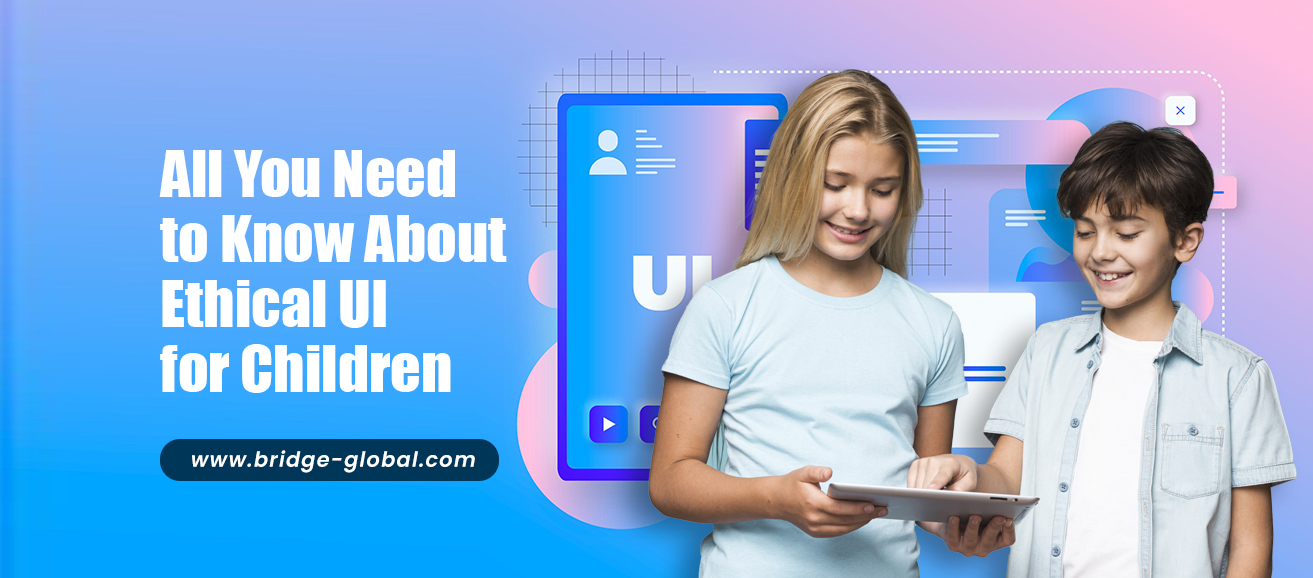Ethical UI for Children – What Is It and How to Do It Right?
Ethical UI for children is becoming more crucial than ever. Kid-safe user experiences are stressed more when considering how today's children grow up in a world full of screens and technology. Though aesthetics are still important, creating safe, healthy, and ethical user interfaces for kids is essential in UX product design.
Ethics in UI design for kids serves as a link between visually appealing interfaces and trustworthy digital interaction. It guarantees that each child's app journey is enjoyable and has an emphasis on educational enrichment. This also ensures safety in UI for children. You can ensure this with the partnership of a seasoned UI UX services provider.
Ethics in UI design for kids supports children's cognitive and emotional development. It instills excellent online digital routines in them. Adherence to child-centric UI guidelines is always crucial in building ethical UX. It can integrate parental controls in UI and various strategies to foster cognitive development in UI design.
So how can you create a more responsible, safe, and inclusive digital environment for kids using ethical UI for children?
UI for Children: Challenges of Designing UX Products
Building an ethical UI for children is not an easy feat. You should be aware of all the challenging aspects involved in crafting child-friendly UI designs. The below-listed challenges are the major ones you should carefully consider before developing offerings that align with ethical UX for kids.
1. Cognitive Development In UI Design
Children of different ages have individual cognitive capacities. Designers must adapt a child-friendly UI design for content, interactions, and interface features to the developmental phases of each age group. Maintaining ethics in UI design for kids with the help of a custom software development company ensures meaningful product engagement and effortless user experiences.
2. Safety
Online safety is of prime importance in kid-safe user experiences. For this, you must get rid of any inappropriate content, restrict unauthorized access, and safeguard your software against potential cybersecurity threats.
3. Privacy
Besides personalization, parental consent must be obtained for using data. Also, reduce the amount of data collection to a bare minimum, especially by avoiding location data or browsing history.
4. Engagement
The major challenge for UI/UX designers is to develop a product that captivates and engages children while preventing an addiction to it. Following the ethics in UI design for kids can avoid sessions that prompt young users to begin a new session due to interruptions. This will nurture engagement and simultaneously prevent addiction.
5. Parental Involvement
Although this is a major challenge, designers must strike a balance between enabling parents to provide a secure experience for their children and providing young users some freedom within the app. You can hire developers with seasoned expertise to incorporate parental controls in UI UX. It will help them monitor their child’s interactions and create filters that block information based on the child’s age. This enables control over the app's content while also not interfering with how the child explores the application.
Designing UX Products for Children of Various Ages
Children go through phases of cognitive, emotional, and social development. Ethical user interfaces for kids must adapt to the changing requirements of children and provide age-appropriate interaction.
The Influence of Critical Phases of Child Development on UI Design
These phases have a big influence on how children engage with digital products. You should consider the ethics in UI design for kids to create apps with kid-safe user experiences.

1. Infancy and Early Childhood (ages 0–5)
Children's cognitive development is in its early phases. So, designing UI for children should be easy, simple, and bright with large interactive features and minimum text. Adding voice-guided interactions is key to increasing engagement.
2. Middle Childhood (ages 6 - 11)
Cognitive capacities grow. Using child-centric UI guidelines, you should design intuitive and entertaining interfaces with interactive content that balances teaching and enjoyment. The visuals should be acceptable to the audience, and the content should be clear and succinct.
3. Adolescence (ages 12 - 18)
Teenagers have excellent cognitive capacities. Although UI/UX design might mimic adult interfaces, it should prioritize safety in UI for children. Factors such as safety, privacy, and content-appropriateness become critical to tailor material to specific interests.
Influence of Ethical UI Design on Children's Cognitive, Emotional, & Social Development
Products with ethical UX for kids vary greatly depending on the age group they target. Here are some examples of how cognitive, emotional, and social growth affects design decisions:
1. Cognitive Development
Consider the approach of cognitive development in UI design to build interactions that correspond to the users’ developmental and cognitive capacities. As they mature, gradually introduce more complicated relationships.
UI for young children should be as easy and clear as possible along with clear directions on what has to be done while avoiding confusing terms and complex circumstances. Designing UI for older children must have increasingly complicated user journeys due to their increasing cognitive skills.
2. Emotional Development
A child-friendly UI design that promotes excellent impressions and creates possibilities for expressing oneself along with feedback understands children's emotional requirements.
Make sure you offer customized feedback components using ethical UX for kids based on their emotional responses. Young kids respond well to cheery animations and encouraging remarks, but older children may prefer more sophisticated activities, unlocking new levels, or earning badges.
3. Social Development
While creating UI for children, consider how they socialize with their peers in digital settings. Incorporate elements that encourage collaboration, sharing, and social learning.
Include activities that let them share virtual toys or resources with their digital classmates. This ethical user interface for kids will educate kids about sharing and collaboration.
Kid-safe user experience should make it possible to share children’s achievements where other kids can comment or post virtual stickers. This will foster social connections and community building within the app.
Privacy & Security - The Two Foundations of Ethical UI Design for Children

For UX product design for children, security, privacy, and data protection are critical. You can ensure safety in UI for children by doing the following:
- Keeping children safe from online threats and cyber criminals
- Making data gathering and sharing with parental controls in UI
- Respecting the privacy of parents and young users builds trust
Consider the following industry guidelines while building ethical UI for children:
1. COPPA (Children’s Online Privacy Protection Act)
COPPA is a US statute that protects the privacy of children under the age of 13. It governs the collection of personal information about minors by websites and online services.
Online platforms or UI for children that collect information from children under the age of 13 must seek verified parental consent before collecting, using, or disclosing such information, according to COPPA. The law also requires the posting of privacy policies, the ability for parents to review and delete their child's information, and the secure storage of collected data.
2. FERPA (Family Educational Rights and Privacy Act)
Another key federal regulation in the United States is FERPA, which protects the privacy of student education data, including those gathered online. FERPA applies to educational agencies and institutions that accept US Department of Education funding. Make sure your child-friendly UI design adheres to this.
3. GDPR (General Data Protection Regulation)
GDPR, among other things, specifies the protection of children's personal data in the European Union. Processing personal data of minors under the age of 16 needs a specific parental agreement, while individual EU members might decrease this age restriction to a minimum of 13 years old. This also needs to be implemented while developing ethical UX for kids.
Tips for Creating an Ethical UI/UX Product for Children
Creating ethical user interfaces for kids necessitates careful consideration. Here are some pointers for creating an effective UX product design for children:
1. Make Use of Vibrant Colors
Choose colors that complement the topic and the age of the child using child-centric UI guidelines.
Preschoolers respond well to warm and cheery hues like brilliant yellows, gentle blues, and vivid greens. These hues are visually pleasing and encourage fun and participation. A color palette like this improves the learning process for young children.
Consider employing strong and colorful hues while designing UI for children. Electric blues, blazing reds, and aggressive oranges for adolescents. These hues elicit feelings of energy and intensity, appealing to the tastes of older children and teens. They make the interface visually appealing and engaging.
2. Make Changes to Interactive Elements
Ethics in UI design for kids requires essential interactive features. The ones fostering exploration and participation are consistent with age-related traits.
The approach of cognitive development in UI design uses large, bright buttons that are easy to tap, slide, or swipe for smaller children. These buttons can activate animations or music effects, offering rapid feedback and improving their motor abilities. Pop-up animations or interactive puzzles with drag-and-drop parts may be both enjoyable and instructive.
Interactive UI for children for older children and teens should include more challenging tasks, such as interactive quizzes or decision-making scenarios inside narrative apps. Implementing drag-and-drop interfaces for creative tasks such as character design or virtual environment creation may also be entertaining. Incorporating gesture-based activities, such as shaking the device for a random result or tilting it for interactive parallax effects, provides a new level of engagement for this age range.
3. Offer Educational Value
The uniqueness of child-friendly UI design in apps is that they are intended to deliver educational value through play, engagement, or discovery. Even applications that do not expressly designate themselves as "educational" can provide tremendous educational value to youngsters.
Many games with ethical user interfaces for kids are intended for enjoyment, including participants strategizing, analyzing circumstances, and making judgments. This improves their critical thinking abilities and encourages them to make quick and educated judgments.
Designing UI for children should include engaging stories that introduce toddlers to new words and phrases. Engaging with characters and these narratives aids with vocabulary expansion and language understanding.
Drawing, music-making, and narrative applications enable youngsters to express themselves artistically. These foster creativity and inventiveness.
Apps that demand precision tapping, swiping, or tilting improve fine motor skills and hand-eye coordination. This approach to cognitive development in UI design enhances their writing, musical instrument playing, and sports participation.
Thematic UI/UX product design for children may pique their interest in a variety of themes by sparking their interest in various fields.
4. Encourage Positive Emotions
It is critical to reinforce good emotions in ethical UX for kids to provide an engaging experience. Here are some efficient methods for accomplishing this:
- Use bright, cheery hues that elicit good feelings using ethics in UI design for kids
- Create welcoming and approachable characters for the app
- Give fast and positive comments for each action or accomplishment
- In your instructions and feedback letters, use cheerful and encouraging language
- Include unexpected interactive features or surprises that elicit good responses
- Adapt the kid-safe app user experience to a child's choices and achievements
- Provide options for children to make inside the app
- Use upbeat background music and fun sound effects
- When children accomplish tasks or reach milestones, use progress trackers, achievement badges, and celebration screens
- Create features that allow youngsters to collaborate with their peers while designing UI for children
5. Safeguard Against Hazardous Content
It is critical to emphasize safety in UI UX for children. Here are some strategies for protecting children from hazardous content:
- Implement a sophisticated content moderation system that screens user-generated content using both automatic filters and human moderators
- To discover and restrict improper information in real time, use keyword filters, picture recognition, and artificial intelligence algorithms
- Label material clearly to identify the target age group using parental controls in UI so that they can make meaningful judgments about what their kids can access
- Include complete parental controls that allow parents to limit material, app usage time, in-app purchases, and social interactions.
- Create secure communication mechanisms that allow children to connect solely with permitted contacts, such as friends and family members if the app incorporates social elements.
- Install a simple reporting system that allows both children and adults to report problematic information or conduct to ensure safety in UI for children
Testing UX Product Design for Children
It is critical to properly test product UI for children and collect detailed feedback from genuine consumers. Testing and feedback guarantee that the interface is interesting and instructional as well as functional.
Why perform user testing while developing a children's app?
We may make assumptions about engaging UI design for children as adults. In contrast, directly asking youngsters will provide more accurate and obvious suggestions about vital aspects. You achieve the following results by integrating real consumers in the testing of child-friendly UI design:

1. User-Centric Design: Use child-centric UI guidelines so that children will assist you in tailoring the interface to their needs and preferences.
2. Usability: Testing detects usability concerns early on. This increases the usability and effectiveness of ethical user interfaces for kids.
3. Relevance of Content: Children's feedback aids in the curation of information that speaks to them, making the experience more engaging and educational.
How to Use Real-World Experiences to Implement UX Product Design for Children
Involving young testers in the quality assurance process needs careful consideration. The following are the measures to take while designing UI for children:
1. Participant Recruitment: Obtain parental consent using parental controls in UI. Aim for participant diversity by considering aspects such as age, gender, socioeconomic background, and technical skill.
2. Provide a Kid-Friendly Atmosphere: Consider leveraging familiar settings such as schools, libraries, or community centers to ensure child-friendly UI designs.
3. Prototyping: Create clickable prototypes using competent tools that mirror the actual user experience for cognitive development in UI design.
3. Moderated and Unmoderated Testing: You may either have a facilitator lead the youngsters through the testing process or let them engage with the prototype without direct supervision.
4. Collect Feedback: To obtain feedback, use a combination of quantitative and qualitative techniques for designing UI for children. Surveys, interviews, and observation notes can all give useful information on the user experience.
5. Parents/Guardian Engagement: Collect input from both youngsters and their parents or guardians. The perspectives of these adults are critical for understanding the context in which the youngsters are using your product.
6. Iterate and Enhance: Analyze the feedback methodically. Determine common themes and topics voiced by youngsters and their parents/guardians.
7. Document and Report: Prepare a detailed report detailing the findings and changes made in response to the comments.
Start Your Journey on Ethical UI for Children!
Ethical UI for children is still a crucial challenge to nail in this digital age. Maintaining the values of accountability, respect, and transparency ensures that children may explore, learn, and enjoy themselves in a safe and principled digital environment.
A seasoned UI UX design company can assist you in developing digital solutions that are specific to your requirements. They will ensure that your product design, whether for children or adults, is intriguing, user-friendly, and secure.



